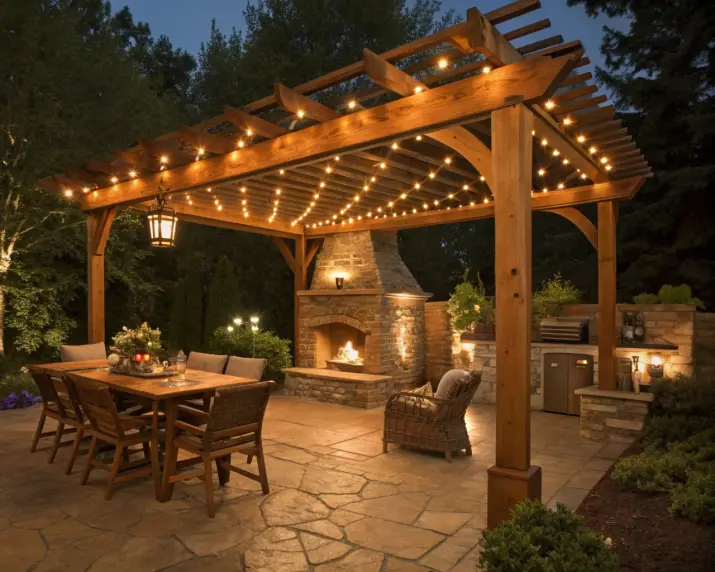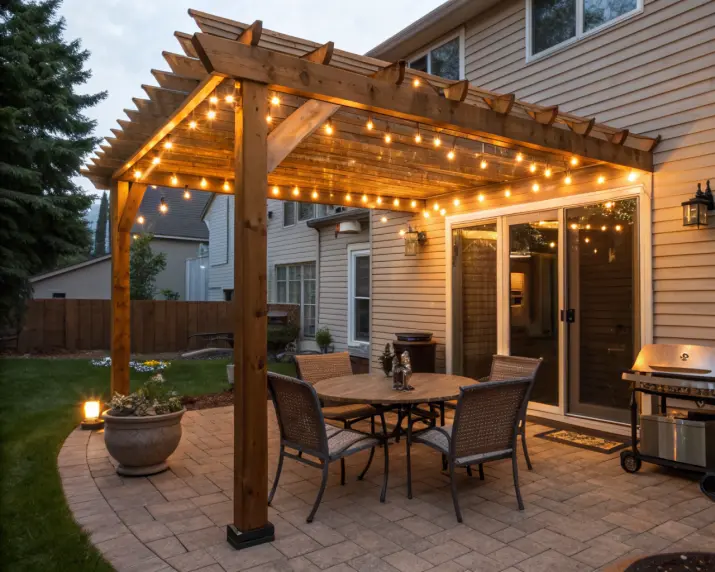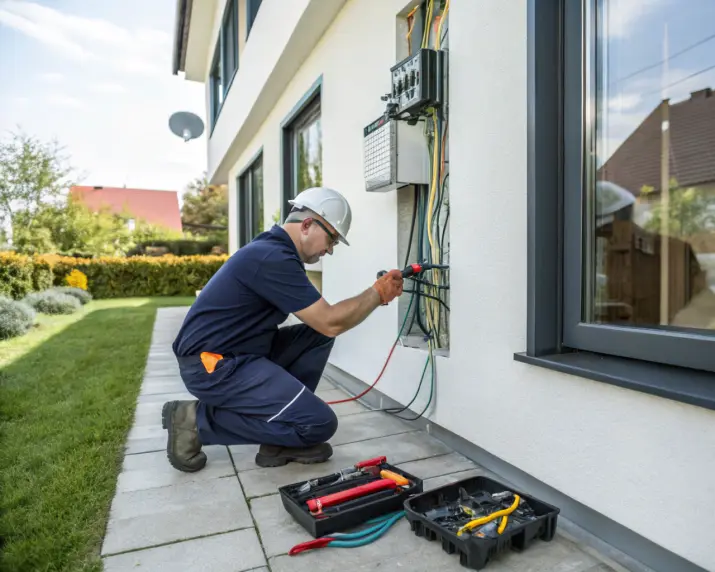String lights are a simple way to shape how patios and pergolas are experienced, and so, they should be treated as functional ambiance. Your outdoor space feels more open, evenings last longer, and gatherings feel natural when outdoor lighting is planned with intent. That shift turns the choice from casual styling to a tool for comfort and connection that is noticed in how people use the area and in how often they return to it.
Practical design choices matter because the layout of the lights determines whether the look feels unified or uneven. Small adjustments, like anchoring lines to structural beams or balancing the spread of bulbs, create the difference between clutter and calm. Durability is part of design too, since outdoor-rated strands and safe connections make sure beauty is matched with reliability.
Think of lighting not as a backdrop but as an active feature. It sets the tone, frames movement, and guides attention to the details you want people to see. The right plan makes a patio or pergola more usable as well as memorable. In this blog, we will explore how to plan string light layouts, what to consider for patios and pergolas, and how thoughtful placement can turn a simple fixture into a lasting element of outdoor living.
Key Design Tips for Setting Up Lights on Patio or Pergola
1. Measuring Your Space Before
How to Calculate the Dimensions of a Patio or Pergola?
Treat measurement as a strategic step and a core part of the plan. Accurate numbers let lighting act like a brand touch that brings people closer and creates trackable moments. Sketch the footprint and mark posts, beams, and edges. Add allowance for drapes, diagonal runs, and any decorative motifs that will repeat across seasons. This planning will turn a handful of bulbs into a coherent visual voice that supports promotions and events. Consider:
- Measure the length and width of the full area.
- Mark each post beam and fixed anchor point.
- Add 2 to 3 feet for drape slack and entry sweeps.
How to Measure Space Before Buying String Lights?
Translate your sketch into run lengths based on the pattern you want. A perimeter run uses far less cord than a canopy or crisscross layout. Note power locations and where staff will pass on busy nights so your lighting supports both guest comfort and operations. Record these details so you can tie light placements back to footfall and tagged posts. Make sure to:
- Calculate the total run for each planned layout style.
- Record outlet positions and run to the nearest power source.
- Account for attachment hardware and tensioning needs.
Recommended Spacing Between Bulbs for Balanced Lighting
Even spacing prevents dark patches and keeps movement safe. Measured choices reduce retrofit costs and give you clean metrics to report at season’s end. Typical strings come with bulbs every 12 to 24 inches, and choosing within that band affects glare and shadow. For dining, choose closer spacing for a warm, intimate wash; for activity zones, wider spacing keeps sight lines open while still creating a pleasant glow.
2. Choosing the Right String Lights
The style of the bulb matters; it is the first signal of the mood you want guests to carry with them. Different types of bulbs sit within different kinds of outdoor lighting, but the focus should be on consistency instead of variety. Pick one pattern and repeat it so the space feels deliberate and memorable.
- Globe bulbs = Clean and steady presence
- Edison bulbs = Vintage warmth and story
- Fairy lights = Delicate, almost weightless
- LED strips = Bold, modern rhythm
Bulb Types and Practical Differences
The choice of bulb also carries operational weight. Edison and globe options offer character but are fragile. LEDs cut energy use, last longer, and keep heat off crowded patios, which means fewer mid-season failures. Fairy strands are inexpensive and simple to replace, a quick win when budgets are tight. Each is valid, but each should be tied to the scale and purpose of the season.
Color Temperature for Setting the Mood
Light tone is a language in itself. Warm white slows people down, helps them linger, and connects with food and conversation. Cool white accelerates movement and brings clarity to events or larger flows. Choosing one tone and holding it across the site ensures that the space reads like a single, intentional story.
Outdoor Rated for Long Term Use
Durability is where good ideas live or die. Weather-resistant sockets and heavy cords keep the look intact through rain or heat. Spending wisely once avoids patchwork repairs that distract from the guest experience and eat away at brand value. When resilience is baked in, the lighting shifts from decoration to a functional promise that quietly builds trust.
3. Layout Guidance: Popular Patterns for Patios and Pergolas

Layout Plans for Different Structures
Every structure asks for its own rhythm. A rectangular patio benefits from order and symmetry, while an L-shaped pergola comes alive when light guides people through the turn. Open decks invite broader gestures, with lines that draw the eye outward to the horizon. Good lighting design is less about filling every corner and more about creating paths, pauses, and moments that feel intentional. The plan becomes a quiet map of how you want people to move and gather.
Creative Ways to Hang Lights
The beauty of overhead light is how it frames the sky. Consider below ideas:
- Zig-zag = Lively, kinetic flow.
- Crisscross = Stable, Balanced tone.
- Canopy/draped = Intimate shelter.
- Perimeter outlining = Clear boundaries, strong frame.
- Chandelier cluster = Dramatic focal point, Natural gathering spot
4. Creating the Perfect Ambiance
Ambiance centers on feeling rather than raw brightness. A space becomes memorable when the light matches the moment. Beautifully lit environments can be quiet and tender or bold and celebratory, depending on how the glow is shaped. For intimate dinners, softer warmth sets a tone of ease, inviting people to linger at the table. For parties, brighter layers bring movement and sparkle, reminding everyone that the night is alive.
Tools add flexibility. Dimmers allow a single string of bulbs to shift from background glow to centerpiece brightness. Smart plugs and timers remove the friction of setup, letting the light come on as naturally as the evening itself. Blending sources also deepens the story. String lights establish rhythm overhead, lanterns and sconces shape the edges, and pathway lights guide the flow between zones.
Here, the patterns become clear:
- Warm, cozy tones slow the pace and invite conversation.
- Brighter layouts energize and mark a celebration.
- Dimmers and smart controls adapt light to the mood.
- Layering different fixtures adds depth and character.
5. Safety & Power Considerations
Good lighting is judged equally by its look and by the safety of its installation. A well-lit environment loses its charm the moment cords tangle, beams strain, or sparks threaten. Treat power and structure as part of the design itself, because when these choices are planned with care, the glow feels effortless and lasting.
- Outdoor-rated extension cords and weatherproof outlets keep the system reliable in rain or heat.
- Pergolas and beams need to carry the weight of the strands without sagging or stress.
- Clearances around wood and roofing protect against fire risks and keep insurance concerns at bay.
Small, invisible steps like these become the backbone of the entire experience. When safety is woven in from the start, the light itself can take center stage.
Installation Planning & Hanging Methods
Lighting looks effortless when it’s hung with intention, but behind every glow is a series of small, practical choices that make it safe, balanced, and durable. The way you secure and position your lights determines their first-evening glow and their long-term endurance through weather, gatherings, and daily use. Avoiding a common lighting installation mistake means treating the setup as a craft: every hook, every cable, every anchor has a role in shaping the final look. Practical planning supports beauty and brings it to the forefront.
1. Securing the Structure
The way lights are secured defines safety while also setting the stage for how the entire space feels. A strand that holds steady on hooks or guide wires tells a story of confidence, while sagging or improvised fixes communicate neglect. Small practical wins here add up quickly. Hooks give a reliable base on walls and beams, poles help establish presence in open patios, and guide wires bring the clean tension needed to stretch strands without strain. Anchors make permanence possible, while zip ties offer flexibility for adjustments when layouts evolve. Treated this way, the hardware works as both a functional element and a contributor to consistency and style. With every strand held firm, the experience reads as deliberate, and that clarity is what people remember long after the night is over.
2. Height & Anchoring Points
Height acts as a measurement and as a signal of the experience you want to create. Too low and the setup becomes an obstacle; too high and the effect drifts out of reach. The right balance creates immersion. Warm light stays within reach but never in the way. In a pergola, lower placements transform the frame into an intimate canopy; on an open patio, height delivers openness and scale. Anchoring points tell a parallel story. Beams in pergolas give natural strength, while poles and cable guides on patios show resourcefulness and purpose. These choices are never invisible: they decide whether the light feels enclosing like a room, or expansive like a horizon. A well-judged anchor makes the environment feel designed rather than improvised, and that difference builds both trust and memory.
3. Weatherproofing Essentials
Weatherproofing is where credibility is either won or lost. If sockets fail in the rain or wires fray in the cold, the entire design collapses into frustration. By contrast, outdoor-rated sockets, insulated wires, and covers turn reliability into part of the experience. Guests never pause to consider them, yet their presence is felt in the uninterrupted glow. In thoughtful lighting design, dependability is the true luxury, the assurance that the light will hold steady through wind, moisture, and temperature shifts. Planning here means the lighting both decorates and endures. That endurance is what gives seasonal setups credibility, what allows a temporary installation to carry the weight of tradition. When the design holds through weather, the space earns trust, and that trust translates into repeat visits and shared moments that stretch beyond the season.
4. Power Source Planning
Power setup begins with a clear plan that avoids the hidden costs of rewiring, overloading, or patching after the fact. Outdoor-rated cords extend reach without drawing attention, quietly signaling sustainability as a value that now resonates beyond aesthetics. Plug-in solutions remain the standard for brightness and control, but only when they are placed with intent, hidden in plain sight so the focus stays on the light, not the wiring. Smart plugs and timers add automation that feels effortless, turning daily switches into quiet consistency. When energy choices are framed as part of the design, they reinforce reliability and align the installation with both purpose and presence.
5. Final Height Considerations
Height directs how people feel inside a space. Strands that hang too low disrupt flow, while lights set too high drift out of reach, breaking the connection between glow and gathering. The balance point lies where safety meets intimacy, keeping pathways clear yet drawing the light close enough to feel personal. This is where planning tends to break down: overlooking how people will move, pause, and look upward. Get this balance right, and the effect is immersive without being intrusive. Height functions as a measurement while also shaping mood, reminding us of the importance of outdoor lighting in shaping environments where people feel comfortable, welcomed, and willing to linger.
Budget & Maintenance Tips
Budget in lighting should be seen beyond cost control; it is the lever that decides whether the display feels fragile or built to last. When funds are allocated with intent, they deliver on three fronts at once: the spend remains predictable, the quality of the look holds over time, and the results can be tied back to measurable value.
That shift turns lighting from a one-off purchase into a resource that keeps delivering on atmosphere, on durability, and on trust. Practical choices matter here because even the smallest adjustments carry weight. A single cord that endures for years, or a fixture designed to withstand weather, becomes proof that discipline in budgeting builds both savings and consistency.
1. DIY vs Hiring Experts
The first fork in the path is whether to take the DIY route or to bring in professionals. DIY gives flexibility, direct control, and the personal satisfaction of crafting the scene yourself. It keeps initial spend lighter but demands time, tools, and patience when problems surface. Hiring experts lifts that burden. While the cost may appear higher, the return is clear in precision, safety, and time saved. Professionals carry tested methods, better access to materials, and an ability to anticipate issues before they interrupt the season. Both routes are valid. The choice depends on what you are really buying: short-term control and savings, or long-term confidence and polish best secured through expert guidance.
2. Quality over Price
The pull toward the lowest price is strong, but in lighting, that often becomes the costliest path. Quality shifts the equation because stronger materials last, resist weather, and demand less repair. This is where the conversation around outdoor lighting installation cost becomes sharper: the upfront figure may read higher, yet over time it reduces replacement, prevents outages, and keeps the display looking intentional. The cheaper route may fill the budget line today, but it drains it again tomorrow. Treat quality as discipline rather than indulgence, and the numbers start working in your favor.
3. Choosing Eco-Friendly Options
Lighting reflects both brightness and footprint. Eco-friendly choices keep the design credible and give the display a voice that audiences increasingly expect. LED bulbs cut consumption without dimming the mood, energy-efficient fixtures extend performance, and timers or smart plugs prevent waste by running only when needed. These decisions protect budgets as well, because lower energy use and longer lifespans compound into savings year after year. Responsibility and beauty work hand in hand here, each reinforcing the other in quiet ways that people notice and trust
Conclusion
Good lighting is a deliberate way of shaping atmosphere and guiding experience. When string lights across patios and pergolas are planned with intent, gatherings slow down, conversations stretch, and the setting leaves an imprint. That shift turns the cost of a project into lasting value that shows up in comfort, mood, and the way evenings are remembered.
Practical choices matter. Strong anchors, weather-rated cords, and measured spacing add reliability while still protecting the look. Small wins add up: a better bulb keeps energy use down, a planned layout reduces strain on the structure, and a balanced design avoids clutter. Sustainability should be part of the story because responsible lighting builds credibility over time.
Elevated Seasons understands how to make that balance real, turning design into both beauty and durability. Contact us for the best outdoor lighting services in LA.





